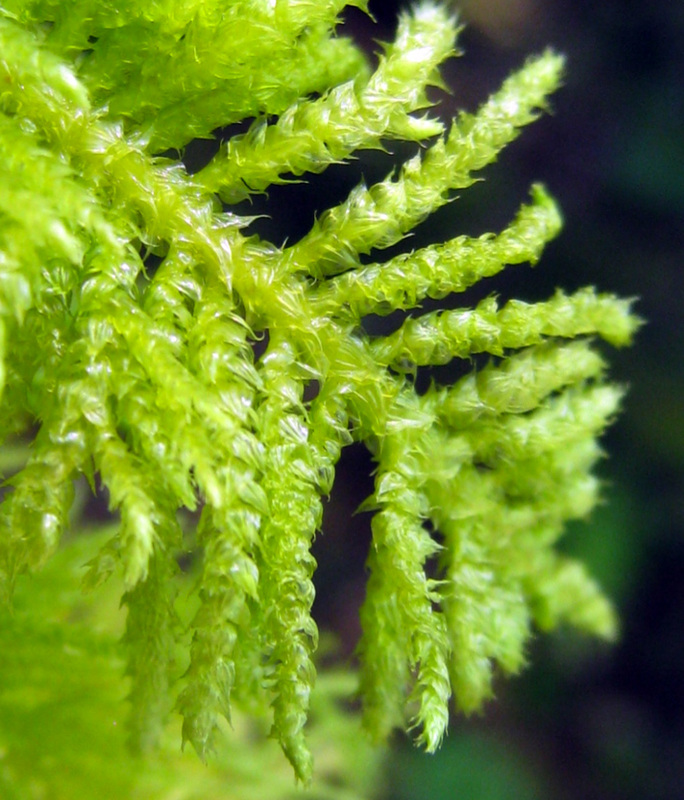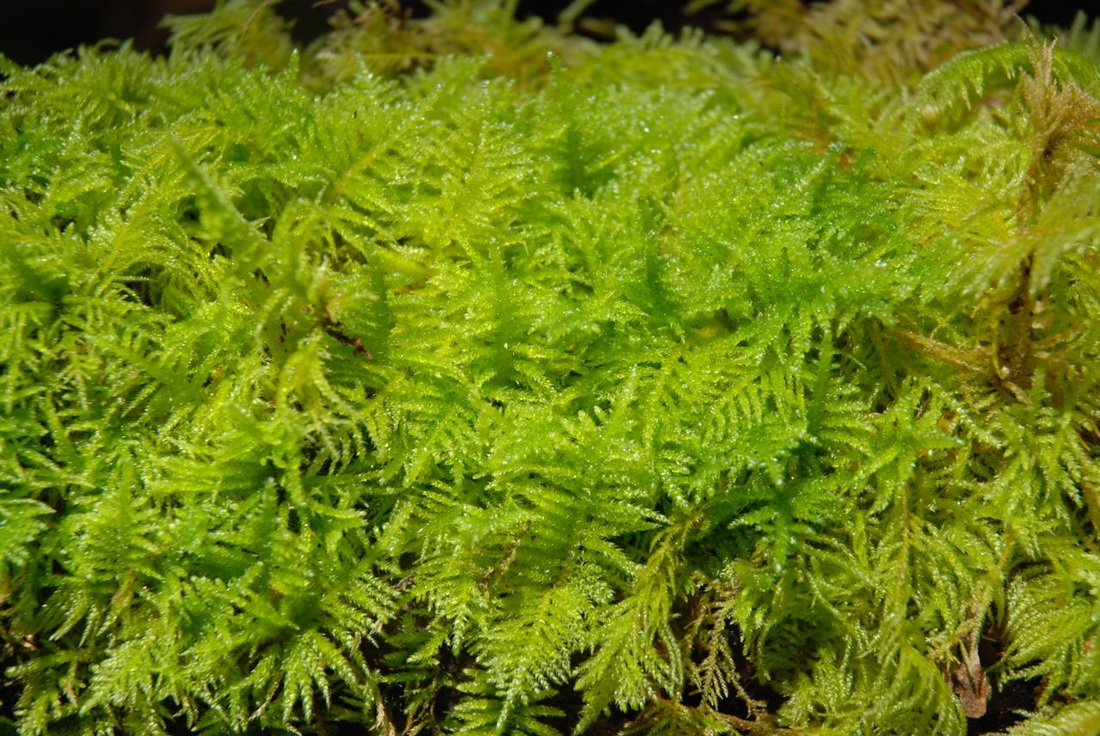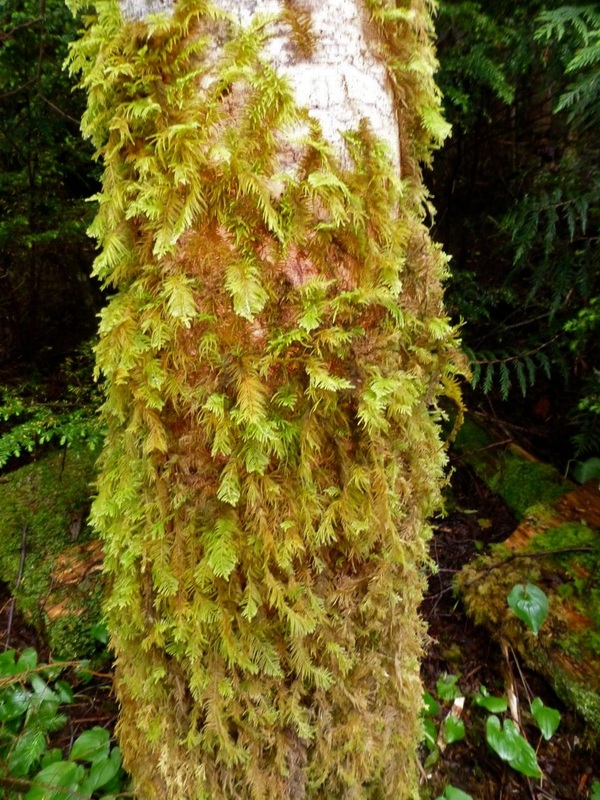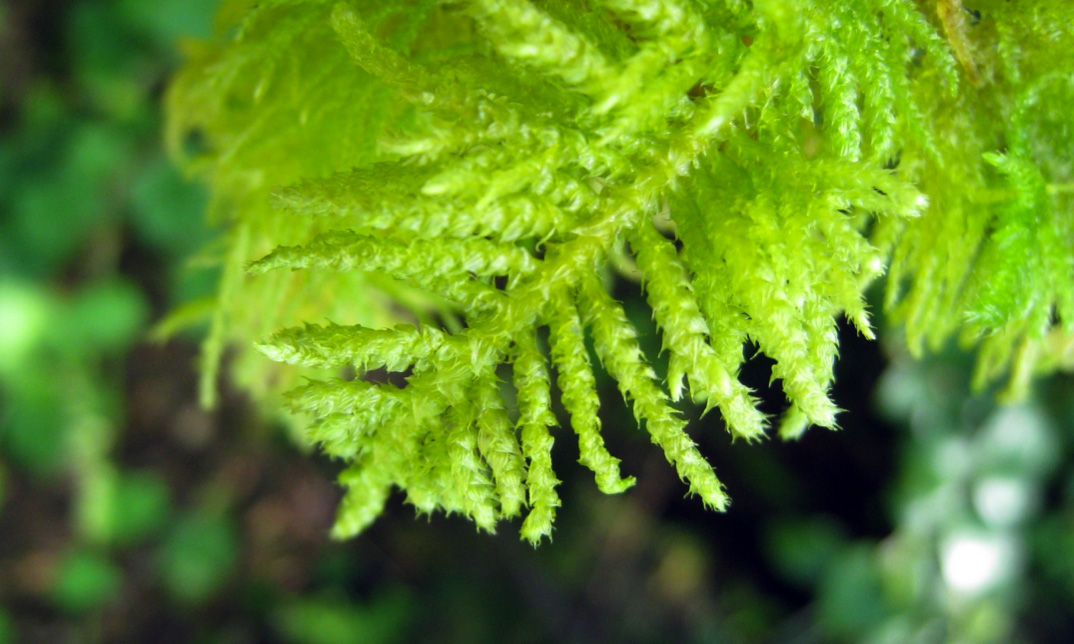Oregon beaked moss, Oregon eurhynchium moss • Kindbergia oregana, Eurhynchium oreganum
Identification
Oregon beaked moss is a large, yellow-green or orange-green moss with a feather or fern-like shape. Its stems are creeping or arched, grow 6-30 cm long, and form loose mats. Its branches are evenly and quite closely spaced, are once pinnate, and have a 'tidy' appearance. They taper towards the tips of the stem, which give the appearance of a fern or a feather. The stem leaves are wider than the branch leaves, and both are no more than 2 mm long. The red-brown sporophytes are common, and their capsules are tipped with long beaks.
Habitat & Range
Oregon beaked moss is a common coastal species. It grows at low elevations on decomposing logs, humus, and on tree trunks. Its west coast range stretches from northern BC to California.
Similar Species
Slender beaked moss (Eurhynchium praelongum) is a similar Kindbergia species. It is smaller, has thinner stems and branches, and its branching is more irregular. Lanky moss (Rhytidiadelphus loreus) branches once-pinnately as well, but its branches are more widely spaced, less regular, and do not have the same fern or feather-like appearance.
Oregon beaked moss is a large, yellow-green or orange-green moss with a feather or fern-like shape. Its stems are creeping or arched, grow 6-30 cm long, and form loose mats. Its branches are evenly and quite closely spaced, are once pinnate, and have a 'tidy' appearance. They taper towards the tips of the stem, which give the appearance of a fern or a feather. The stem leaves are wider than the branch leaves, and both are no more than 2 mm long. The red-brown sporophytes are common, and their capsules are tipped with long beaks.
Habitat & Range
Oregon beaked moss is a common coastal species. It grows at low elevations on decomposing logs, humus, and on tree trunks. Its west coast range stretches from northern BC to California.
Similar Species
Slender beaked moss (Eurhynchium praelongum) is a similar Kindbergia species. It is smaller, has thinner stems and branches, and its branching is more irregular. Lanky moss (Rhytidiadelphus loreus) branches once-pinnately as well, but its branches are more widely spaced, less regular, and do not have the same fern or feather-like appearance.
References
Ellis, S. Kindbergia oregana (syn. Eurhynchium oreganum). Introduction to Bryophytes. Biology 321, Department of Biology, University of British Columbia, Vancouver. Accessed 03/09/2013.
Eurhynchium oreganum (Sull.) Jaeg. In Klinkenberg, Brian. (Ed.). E-Flora BC: Electronic Atlas of the Plants of British Columbia. Lab for Advanced Spatial Analysis, Department of Geography, University of British Columbia, Vancouver. Accessed 03/09/2013.
Kindbergia oregana (Sullivant) Ochyra [Brachytheciaceae]. California Mosses eFlora. University Herbarium, University of California, Berkeley. Accessed 03/09/2013.
Pojar, J. and MacKinnon, A. (1994). Plants of Coastal British Columbia. Vancouver, BC: Lone Pine Publishing. P. 470.
Authors and editors of page
Kelly Fretwell and Brian Starzomski (2013).
Ellis, S. Kindbergia oregana (syn. Eurhynchium oreganum). Introduction to Bryophytes. Biology 321, Department of Biology, University of British Columbia, Vancouver. Accessed 03/09/2013.
Eurhynchium oreganum (Sull.) Jaeg. In Klinkenberg, Brian. (Ed.). E-Flora BC: Electronic Atlas of the Plants of British Columbia. Lab for Advanced Spatial Analysis, Department of Geography, University of British Columbia, Vancouver. Accessed 03/09/2013.
Kindbergia oregana (Sullivant) Ochyra [Brachytheciaceae]. California Mosses eFlora. University Herbarium, University of California, Berkeley. Accessed 03/09/2013.
Pojar, J. and MacKinnon, A. (1994). Plants of Coastal British Columbia. Vancouver, BC: Lone Pine Publishing. P. 470.
Authors and editors of page
Kelly Fretwell and Brian Starzomski (2013).







